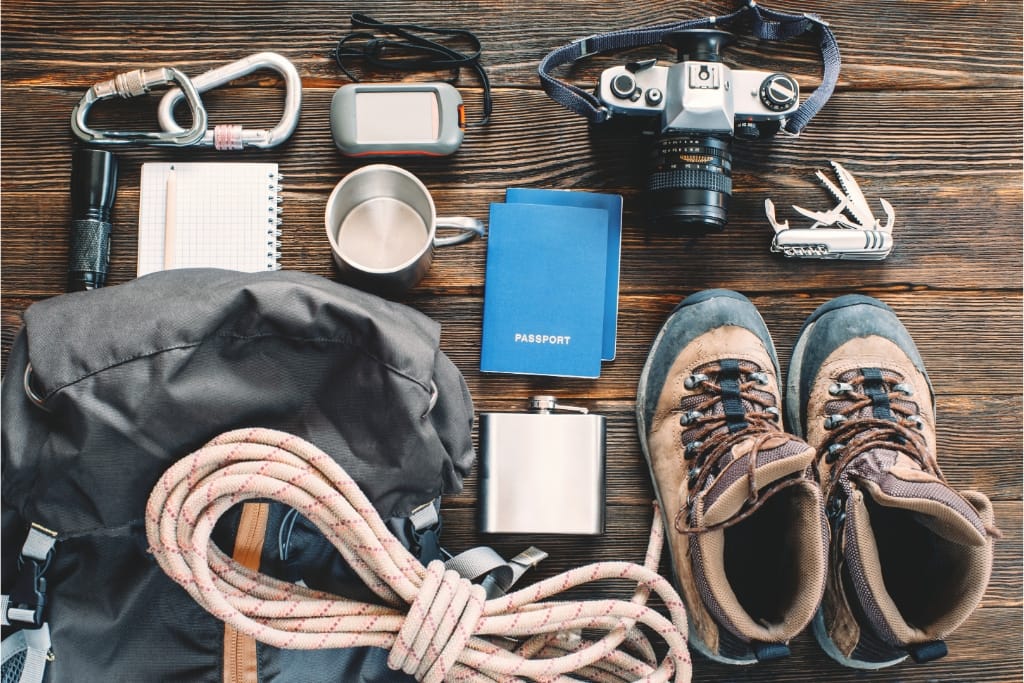Hiking can be one of the most rewarding ways to connect with nature, offering stunning views, fresh air, and a sense of adventure.
However, preparation and awareness are key to ensuring your experience remains safe and enjoyable.
With the right knowledge and strategies, you can confidently tackle your next hiking excursion.
Let's walk through some vital tips to help you stay secure on the trails and make the most of your outdoor adventure.
1)) Plan Your Route
Planning your route is one of the most essential steps for a safe and enjoyable hiking experience.
Start by selecting a trail that matches your skill level and fitness, then take time to research its length, elevation gain, and current conditions.
Use detailed maps or trustworthy apps to familiarize yourself with key landmarks, potential hazards, and water sources along the way.
Always check the weather forecast in advance and be aware of any regulations or permits required for the area.
Taking these steps ensures you’re well-prepared and ready to fully enjoy your time on the trail.
2)) Check Weather Forecast
Checking the weather forecast is a critical step in preparing for any hiking trip.
Sudden weather changes can significantly impact safety and comfort on the trail, so it's essential to get an accurate picture of the conditions beforehand.
Look for updates on temperature, precipitation, wind speed, and potential storms in the area you’ll be hiking.
Consider how these elements might affect the terrain and your ability to complete the route.
Always prepare for the possibility of unexpected weather by packing appropriate gear, such as extra layers, rain protection, and emergency supplies.
Staying informed about the forecast helps you make smarter decisions and adds a layer of security to your adventure.
3)) Pack Essentials
Packing the right essentials is fundamental to ensuring a safe and successful hiking trip.
Start by equipping yourself with the ten hiking essentials, which include navigation tools, a first aid kit, sufficient food, water, and necessary layers for varying weather.
Items like a flashlight, multi-tool, emergency shelter, and fire-starting equipment can also prove invaluable in unexpected situations.
It’s important to balance carrying enough for your safety without overloading your pack to ensure comfort while hiking.
Thoughtful preparation of your gear empowers you to handle challenges confidently and enjoy your time outdoors to the fullest.
4)) Wear Proper Footwear
Wearing proper footwear is crucial for both comfort and safety while hiking.
Choose hiking boots or shoes that suit the trail conditions, whether it’s rugged terrain, muddy paths, or smooth trails.
Ensure they provide adequate support, fit well, and are broken in to prevent blisters or discomfort during your hike.
Look for footwear with durable soles that offer good traction to reduce the risk of slips and falls.
Wearing moisture-wicking socks can help keep your feet dry and prevent chafing.
Prioritizing the right footwear allows you to hike confidently and stay focused on enjoying the beauty of your surroundings.
5)) Stay Hydrated
Staying hydrated is essential for maintaining energy levels and preventing dehydration while hiking.
Always carry enough water for the entire trip, keeping in mind the trail conditions, your exertion level, and the weather.
A general guideline is to drink at least half a liter of water per hour of moderate activity, but this can vary based on individual needs.
Consider bringing a water filtration device or purification tablets if your route includes natural water sources, allowing you to refill safely as needed.
Prioritizing hydration ensures your body stays functional and helps you fully enjoy your hiking experience.
6)) Bring A Map/Compass
Bringing a map and compass is an indispensable part of hiking preparedness, ensuring you have reliable navigation tools in case technology fails.
While GPS devices and smartphones are helpful, they can run out of battery or lose signal, making traditional tools like maps and compasses crucial backups.
Familiarize yourself with how to read a topographic map and use a compass before hitting the trail, as these skills can be lifesaving in unfamiliar or challenging terrains.
Keep the map in a waterproof case to protect it from the elements, and store the compass in an easily accessible pocket.
With these tools in your pack and the knowledge to use them, you can confidently explore new trails and stay on course during your adventures.
7)) Inform Someone Of Plans
Informing someone of your plans before heading out on a hike is a vital step for your safety.
Share details such as your intended route, expected return time, and any backup plans in case of emergencies.
Providing this information ensures that someone knows where you are and can notify authorities to assist should anything go wrong.
Include contact details, like the ranger station number or emergency services for the area, as part of your plan.
Taking the time to inform a trusted person increases your safety and offers peace of mind, allowing you to focus fully on enjoying your hike.
8)) Know Your Limits
Understanding and respecting your physical and mental limits is essential when planning and embarking on a hike.
Assess your fitness level, experience, and familiarity with the trail before committing to a route.
Avoid pushing yourself beyond your capabilities, as overexertion can lead to accidents, injuries, or an inability to complete the hike.
Pay attention to your body’s signals, such as fatigue, pain, or dehydration, and adjust your pace or rest as needed.
By recognizing your limits and making informed decisions, you enhance your hiking experience and ensure both your safety and well-being throughout the adventure.
9)) Dress In Layers
Dressing in layers is a smart approach to staying comfortable and protected from changing weather conditions during a hike.
Start with a moisture-wicking base layer to keep sweat away from your skin, followed by an insulating layer like fleece or down to retain warmth.
Finish with a waterproof and wind-resistant outer layer to shield yourself from rain, wind, or snow.
Choose clothing materials such as synthetic fabrics or wool that dry quickly and provide adequate ventilation.
Layering allows you to easily add or remove pieces depending on the temperature and effort level, ensuring you remain comfortable and ready to enjoy your hike regardless of weather changes.
10)) Start Early
Starting your hike early in the day provides numerous advantages that contribute to a safer and more enjoyable experience.
Early departures help you avoid the midday heat, reducing the risk of overheating and dehydration, especially during warmer months.
Hiking in the morning also increases your chances of spotting wildlife, as many animals are most active during these hours.
An early start gives you a time buffer, ensuring you can complete your trek well before nightfall, reducing the chances of navigating in low visibility.
By starting early, you set yourself up for a comfortable and stress-free adventure, making the most of your hike from beginning to end.
11)) Stay On Trails
Staying on designated trails is fundamental to preserving the environment and ensuring your safety while hiking.
Trails are carefully designed to minimize impact on the surrounding ecosystems and provide a safe path for users.
Venturing off-trail can cause harm to fragile plant life, disturb wildlife, and contribute to soil erosion.
It also increases the risk of getting lost or encountering hazardous terrain.
Follow trail markers and respect any signs or barriers put in place by park authorities, as they are there to protect both nature and hikers.
By staying on the trails, you help maintain the beauty of the outdoors and enjoy your hike with confidence and respect for the environment.
12)) Carry A First-Aid Kit
Bringing a well-stocked first-aid kit is an essential component of hiking preparedness, ensuring you can respond effectively to minor injuries or medical issues on the trail.
Your kit should include items such as adhesive bandages, antiseptic wipes, gauze, medical tape, tweezers, and any personal medications you may need.
It's also wise to pack items like blister treatments, pain relievers, and an emergency blanket to address common hiking mishaps.
Familiarize yourself with the contents of your kit and learn how to use them before setting out.
Having a first-aid kit on hand empowers you to handle unexpected situations and safeguards your health, reassuring you as you explore the outdoors.
13)) Protection From The Sun
Protecting yourself from the sun is crucial to ensuring your safety and comfort during a hike, particularly in exposed areas or at high altitudes.
Wear a wide-brimmed hat to shield your face, neck, and ears from direct sunlight, and choose sunglasses with UV protection to safeguard your eyes.
Apply a broad-spectrum sunscreen with a high SPF before starting your hike, reapplying it every two hours, or after sweating.
Lightweight, long-sleeve clothing with UPF protection can also provide an added layer of defense against harmful UV rays.
By taking these precautions, you reduce the risks of sunburn and heat-related illnesses, allowing you to fully enjoy your time on the trail.
14)) Beware Of Wildlife
Being aware of wildlife during a hike is essential for your safety and the well-being of the animals you may encounter.
Familiarize yourself with the types of wildlife common to the area and learn how to avoid potentially dangerous situations.
Keep a safe distance from all animals, regardless of size, as approaching them can provoke defensive behavior.
Store food securely and dispose of waste properly to avoid attracting wildlife to campsites or trails.
Never feed wild animals, as it disrupts their natural foraging habits and can make them reliant on human food.
By respecting wildlife from a distance, you ensure a harmonious experience while preserving the natural ecosystem for future hikers to enjoy.
15)) Leave No Trace
Practicing Leave No Trace principles is vital to preserving the natural beauty and integrity of outdoor spaces for generations to come.
These guidelines emphasize minimizing your impact by staying on trails, properly disposing of all waste, and respecting wildlife and other visitors.
Always pack out what you pack in, including food wrappers, leftover snacks, and any other trash.
Avoid picking plants, disturbing natural features, or leaving any markings on rocks or trees.
The goal is to leave the environment as pristine as you found it, ensuring that future adventurers can enjoy the same untouched beauty.
By committing to Leave No Trace practices, you help protect the environment and set a positive example for others to follow.
16)) Carry Extra Food
Packing extra food for your hike is a smart and practical step to ensure you have enough energy throughout your adventure, especially if there are delays or unexpected challenges.
Energy-dense snacks like trail mix, granola bars, dried fruits, and nuts are excellent choices as they are lightweight, non-perishable, and easy to consume on the go.
Consider including some items with protein or carbohydrates to help sustain your energy levels during longer hikes.
Properly storing your food in sealed containers or bags will also protect it from wildlife.
Carrying extra food not only keeps you fueled but also provides peace of mind, allowing you to focus fully on the joy of your outdoor experience.
17)) Bring A Flashlight
Carrying a flashlight on your hike is an essential safety measure that ensures you're prepared for low-light or unexpected emergencies.
Whether you're navigating through dense forests, encountering an unanticipated delay, or getting caught out after sunset, a reliable flashlight helps you see clearly and stay on the right path.
Choose a durable, waterproof flashlight with a strong beam, and consider packing extra batteries to ensure uninterrupted use.
Headlamps are an excellent hands-free alternative, providing continuous light while allowing you to use your hands freely.
By bringing a flashlight, you enhance your safety and can confidently handle any situation, even as daylight fades.
18)) Prepare For Emergencies
Preparing for emergencies is a critical aspect of ensuring safety and readiness during a hike or outdoor adventure.
Start by informing someone of your planned route and expected return time, so they can act if something goes wrong.
Carry essential emergency gear like a fully stocked first-aid kit, a multi-tool, a whistle, and waterproof matches or a fire starter.
A map, compass, or GPS device is invaluable for navigation in unfamiliar areas, especially if cell service is unreliable.
Pack a thermal blanket or emergency bivvy to stay warm in unexpected weather conditions.
Preparing for emergencies equips you to handle unexpected challenges effectively, giving you confidence as you explore.
Pro-Tip: Investing in a high-quality emergency survival kit is a practical and cost-effective choice for any hiker.
Pre-assembled survival kits often include essential items like first-aid supplies, fire starters, a whistle, a thermal blanket, and more, all packed into a compact, durable case.
Purchasing a complete kit saves you the time and effort of sourcing each item separately, and it often costs less than buying individual pieces.
A well-designed kit ensures that all components are compatible, providing you with reliable tools that work together when you need them most.
By choosing a quality survival kit, you’re not only saving money but also ensuring peace of mind on every adventure.
19)) Know Altitude Risks
Understanding and preparing for altitude risks is essential when hiking in higher elevations, where reduced oxygen levels can affect your body and performance.
Symptoms of altitude sickness, such as headaches, nausea, and shortness of breath, can develop rapidly and escalate if not addressed.
Gradual acclimatization is key—ascend slowly to allow your body to adjust, and stay hydrated by drinking plenty of water.
Avoid overexerting yourself, and listen to your body for any warning signs.
Carry medication like acetazolamide if you’re prone to altitude sickness, and always know when to turn back if symptoms worsen.
By prioritizing your safety and taking preventative measures, you can confidently enjoy the challenges and beauty of high-altitude environments.
20)) Keep Communication Devices
Keeping communication devices with you during a hike is essential for staying connected and ensuring your safety in case of emergencies.
A fully charged cell phone is the most common option, but it’s important to remember that service may be limited in remote areas.
Consider carrying a satellite phone, personal locator beacon (PLB), or two-way radio as backups, especially for longer or more remote trips, as these devices can provide reliable communication even when cellular networks fail.
Always ensure your devices are protected from the elements with waterproof cases or bags, and bring a portable charger or power bank to keep them functional.
By keeping communication devices on hand, you increase your ability to seek help and share vital information, giving you peace of mind as you explore.
Conclusion
Proper preparation and mindfulness are key to ensuring a safe and enjoyable outdoor adventure.
From packing extra food and carrying emergency supplies to being aware of altitude risks and staying connected with reliable communication devices, each step contributes to your well-being and readiness.
By taking responsibility for your safety and respecting nature's unpredictability, you set yourself up for a fulfilling experience that allows you to fully appreciate the wonders of the great outdoors.
Download Our Free E-book!







